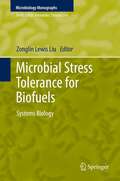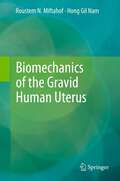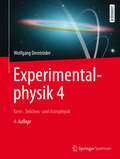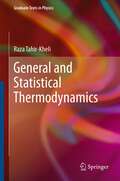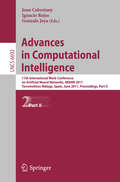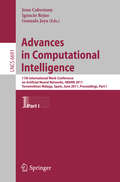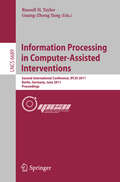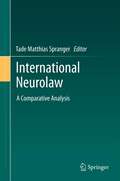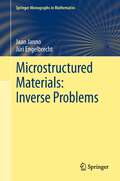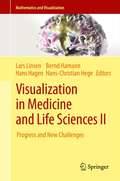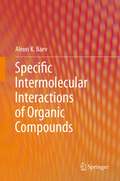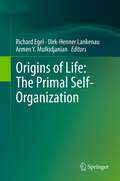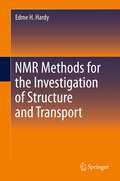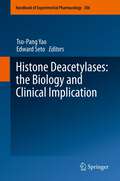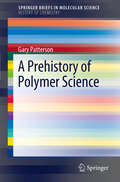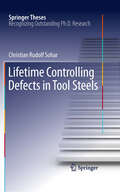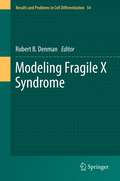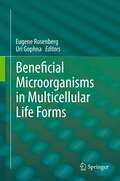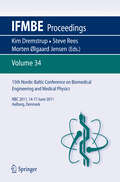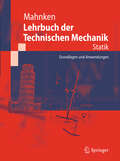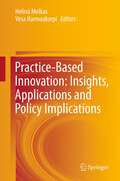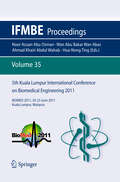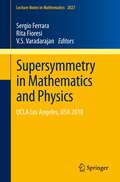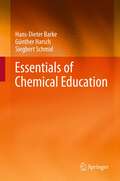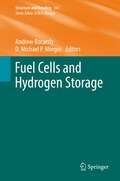- Table View
- List View
Microbial Stress Tolerance for Biofuels: Systems Biology (Microbiology Monographs #22)
by Zonglin Lewis LiuThe development of sustainable and renewable biofuels is attracting growing interest. It is vital to develop robust microbial strains for biocatalysts that are able to function under multiple stress conditions. This Microbiology Monograph provides an overview of methods for studying microbial stress tolerance for biofuels applications using a systems biology approach.Topics covered range from mechanisms to methodology for yeast and bacteria, including the genomics of yeast tolerance and detoxification; genetics and regulation of glycogen and trehalose metabolism; programmed cell death; high gravity fermentations; ethanol tolerance; improving biomass sugar utilization by engineered Saccharomyces; the genomics on tolerance of Zymomonas mobilis; microbial solvent tolerance; control of stress tolerance in bacterial host organisms; metabolomics for ethanologenic yeast; automated proteomics work cell systems for strain improvement; and unification of gene expression data for comparable analyses under stress conditions.
Biomechanics of the Gravid Human Uterus
by Roustem N. Miftahof Hong Gil NamThe complexity of human uterine function and regulation is one of the great wonders of nature and represents a daunting challenge to unravel. This book is dedicated to the biomechanical modeling of the gravid human uterus and gives an example of the application of the mechanics of solids and the theory of soft shells to explore medical problems of labor and delivery. After a brief overview of the anatomy, physiology and biomechanics of the uterus, the authors focus mainly on electromechanical wave processes, their origin, dynamics, and neuroendocrine and pharmacological modulations. In the last chapter applications, pitfalls and problems related to modeling and computer simulations of the pregnant uterus and pelvic floor structures are discussed. A collection of exercises is added at the end of each chapter to help readers with self-evaluation.The book serves as an invaluable source of information for researchers, instructors and advanced undergraduate and graduate students interested in systems biology, applied mathematics and biomedical engineering.
Experimentalphysik 4: Kern-, Teilchen- und Astrophysik (Springer-Lehrbuch)
by Wolfgang DemtröderBand 4 des Lehrbuchs zur Experimentalphysik beinhaltet den Stoff des vierten Semesters im Physikstudium. So wie bei den ersten drei Bänden auch präsentiert der Autor die Inhalte leicht verständlich, dabei möglichst quantitativ und angepasst an den Bachelor-Studiengang. Durchgerechnete Beispiele und Übungsaufgaben mit ausführlichen Lösungen helfen dabei, den Stoff zu bewältigen und regen zum Mitdenken an. Die vollständig überarbeitete Neuauflage wurde um Abschnitte u. a. zum LHC-Beschleuniger, zu extrasolaren Planeten und dunkler Materie erweitert.
General and Statistical Thermodynamics (Graduate Texts in Physics)
by Raza Tahir-KheliThis textbook explains completely the general and statistical thermodynamics. It begins with an introductory statistical mechanics course, deriving all the important formulae meticulously and explicitly, without mathematical short cuts. The main part of the book deals with the careful discussion of the concepts and laws of thermodynamics, van der Waals, Kelvin and Claudius theories, ideal and real gases, thermodynamic potentials, phonons and all the related aspects. To elucidate the concepts introduced and to provide practical problem solving support, numerous carefully worked examples are of great value for students. The text is clearly written and punctuated with many interesting anecdotes. This book is written as main textbook for upper undergraduate students attending a course on thermodynamics.
Advances in Computational Intelligence: 11th International Work-Conference on Artificial Neural Networks, IWANN 2011, Torremolinos-Málaga, Spain, June 8-10, 2011, Proceedings, Part II (Lecture Notes in Computer Science #6692)
by Joan Cabestany Ignacio Rojas Gonzalo JoyaThis two-volume set LNCS 6691 and 6692 constitutes the refereed proceedings of the 11th International Work-Conference on Artificial Neural Networks, IWANN 2011, held in Torremolinos-Málaga, Spain, in June 2011. The 154 revised papers were carefully reviewed and selected from 202 submissions for presentation in two volumes. The second volume includes 76 papers organized in topical sections on video and image processing; hybrid artificial neural networks: models, algorithms and data; advances in machine learning for bioinformatics and computational biomedicine; biometric systems for human-machine interaction; data mining in biomedicine; bio-inspired combinatorial optimization; applying evolutionary computation and nature-inspired algorithms to formal methods; recent advances on fuzzy logic and soft computing applications; new advances in theory and applications of ICA-based algorithms; biological and bio-inspired dynamical systems; and interactive and cognitive environments. The last section contains 9 papers from the International Workshop on Intelligent Systems for Context-Based Information Fusion, ISCIF 2011, held at IWANN 2011.
Advances in Computational Intelligence: 11th International Work-Conference on Artificial Neural Networks, IWANN 2011, Torremolinos-Málaga, Spain, June 8-10, 2011, Proceedings, Part I (Lecture Notes in Computer Science #6691)
by Joan Cabestany Ignacio Rojas Gonzalo JoyaThis two-volume set LNCS 6691 and 6692 constitutes the refereed proceedings of the 11th International Work-Conference on Artificial Neural Networks, IWANN 2011, held in Torremolinos-Málaga, Spain, in June 2011. The 154 revised papers were carefully reviewed and selected from 202 submissions for presentation in two volumes. The first volume includes 69 papers organized in topical sections on mathematical and theoretical methods in computational intelligence; learning and adaptation; bio-inspired systems and neuro-engineering; hybrid intelligent systems; applications of computational intelligence; new applications of brain-computer interfaces; optimization algorithms in graphic processing units; computing languages with bio-inspired devices and multi-agent systems; computational intelligence in multimedia processing; and biologically plausible spiking neural processing.
Information Processing in Computer-Assisted Interventions: Second International Conference, IPCAI 2011, Berlin, Germany, June 22, 2011, Proceedings (Lecture Notes in Computer Science #6689)
by Russell H. Taylor Guang-Zhong YangThis book constitutes the proceedings of the Second International Conference on Information Processing in Computer-Assisted Interventions IPCAI 2011, held in Berlin, Germany, on June 22, 2011. The 17 papers presented were carefully reviewed and selected from 29 submissions. The focus of the conference is the use of information technology in interventional medicine, including real-time modeling and analysis, technology, human-machine interfaces, and systems associated with operating rooms and interventional suites. It also covers the overall information flow associated with intervention planning, execution, follow-up, and outcome analysis; as well as training and skill assessment for such procedures.
International Neurolaw: A Comparative Analysis
by Tade Matthias Matthias SprangerWhereas the past few years have repeatedly been referred to as the “era of biotechnology”, most recently the impression has emerged that at least the same degree of attention is being paid to the latest developments in the field of neurosciences. It has now become nearly impossible to maintain an overview of the number of research projects dealing with the functionality of the brain – for example concerning its organizational structure – or projects dealing with the topics of legal responsibility, brain-computer interface applications, neuromarketing, lie detection or mind reading. These procedures are connected to a number of legal questions concerning the framework conditions of research projects as well as the right approach to the findings generated. Given the primary importance of the topic for the latest developments, it is essential to compare the different legal systems and strategies that they offer for dealing with these legal implications. Therefore, the book International Neurolaw – A Comparative Analysis contains several country reports from around the world, as well as those of international organizations such as UNESCO, in order to show the different legal approaches to the topic and possible interactions.
Microstructured Materials: Inverse Problems (Springer Monographs in Mathematics)
by Jaan Janno Jüri EngelbrechtComplex, microstructured materials are widely used in industry and technology and include alloys, ceramics and composites. Focusing on non-destructive evaluation (NDE), this book explores in detail the mathematical modeling and inverse problems encountered when using ultrasound to investigate heterogeneous microstructured materials. The outstanding features of the text are firstly, a clear description of both linear and nonlinear mathematical models derived for modelling the propagation of ultrasonic deformation waves, and secondly, the provision of solutions to the corresponding inverse problems that determine the physical parameters of the models. The data are related to nonlinearities at both a macro- and micro- level, as well as to dispersion. The authors’ goal has been to construct algorithms that allow us to determine the parameters within which we are required to characterize microstructure. To achieve this, the authors not only use conventional harmonic waves, but also propose a novel methodology based on using solitary waves in NDE. The book analyzes the uniqueness and stability of the solutions, in addition to providing numerical examples.
Visualization in Medicine and Life Sciences II: Progress and New Challenges (Mathematics and Visualization)
by Lars Linsen Hans Hagen Bernd Hamann Hans-Christian HegeFor some time, medicine has been an important driver for the development of data processing and visualization techniques. Improved technology offers the capacity to generate larger and more complex data sets related to imaging and simulation. This, in turn, creates the need for more effective visualization tools for medical practitioners to interpret and utilize data in meaningful ways. The first edition of Visualization in Medicine and Life Sciences (VMLS) emerged from a workshop convened to explore the significant data visualization challenges created by emerging technologies in the life sciences. The workshop and the book addressed questions of whether medical data visualization approaches can be devised or improved to meet these challenges, with the promise of ultimately being adopted by medical experts. Visualization in Medicine and Life Sciences II follows the second international VMLS workshop, held in Bremerhaven, Germany, in July 2009. Internationally renowned experts from the visualization and driving application areas came together for this second workshop. The book presents peer-reviewed research and survey papers which document and discuss the progress made, explore new approaches to data visualization, and assess new challenges and research directions.
Specific Intermolecular Interactions of Organic Compounds
by Alexei K. BaevProf. Baev presents in his book the development of the thermodynamic theory of specific intermolecular interactions for a wide spectrum of organic compounds: ethers, ketones, alcohols, carboxylic acids, and hydrocarbons. The fundamentals of an unconventional approach to the theory of H-bonding and specific interactions are formulated based on a concept of pentacoordinate carbon atoms. New types of hydrogen bonds and specific interactions are substantiated and on the basis of the developed methodology their energies are determined. The system of interconnected quantitative characteristics of the stability of specific intermolecular interactions is presented. The laws of their transformations are discussed and summarized. The new concept of the extra stabilizing effect of isomeric methyl groups on the structure and stability of organic molecules is introduced and the destabilization action on specific interactions is outlined.
Origins of Life: The Primal Self-Organization
by Richard Egel, Dirk-Henner Lankenau and Armen Y. MulkidjanianIf theoretical physicists can seriously entertain canonical “standard models” even for the big-bang generation of the entire universe, why cannot life scientists reach a consensus on how life has emerged and settled on this planet? Scientists are hindered by conceptual gaps between bottom-up inferences (from early Earth geological conditions) and top-down extrapolations (from modern life forms to common ancestral states). This book challenges several widely held assumptions and argues for alternative approaches instead. Primal syntheses (literally or figuratively speaking) are called for in at least five major areas. (1) The first RNA-like molecules may have been selected by solar light as being exceptionally photostable. (2) Photosynthetically active minerals and reduced phosphorus compounds could have efficiently coupled the persistent natural energy flows to the primordial metabolism. (3) Stochastic, uncoded peptides may have kick-started an ever-tightening co-evolution of proteins and nucleic acids. (4) The living fossils from the primeval RNA World thrive within modern cells. (5) From the inherently complex protocellular associations preceding the consolidation of integral genomes, eukaryotic cell organization may have evolved more naturally than simple prokaryote-like life forms. – If this book can motivate dedicated researchers to further explore the alternative mechanisms presented, it will have served its purpose well.
NMR Methods for the Investigation of Structure and Transport
by Edme H HardyMethods of nuclear magnetic resonance (NMR) are increasingly applied in engineering sciences. The book summarizes research in the field of chemical and process engineering performed at the Karlsruhe Institute of Technology (KIT). Fundamentals of the methods are exposed for readers with an engineering background. Applications cover the fields of mechanical process engineering (filtration, solid-liquid separation, powder mixing, rheometry), chemical process engineering (trickle-bed reactor, ceramic sponges), bioprocess engineering (biofilm growth), and food process engineering (microwave heating, emulsions). Magnetic Resonance Imaging (MRI) as well as low-field NMR are covered with notes on hardware. Emphasis is placed on quantitative data analysis and image processing.
Histone Deacetylases: the Biology and Clinical Implication (Handbook of Experimental Pharmacology #206)
by Tso-Pang Yao and Edward SetoThe book highlights work from many different labs that taught us abnormal HDACs potentially contribute to the development or progression of many human diseases including immune dysfunctions, heart disease, cancer, memory impairment, aging, and metabolic disorders.
A Prehistory of Polymer Science (SpringerBriefs in Molecular Science #2)
by Gary Patterson Carnegie Mellon UniversityPolymer science is now an active and thriving community of scientists, engineers and technologists, but there was a time, not so long ago, when there was no such community. The prehistory of polymer science helps to provide key insights into current issues and historical problems. The story will be divided into an ancient period ( from Greek times to the creation of the molecular consensus), a nascent period (from Dalton to Kekule to van’t Hoff) and a period of paradigm formation and controversy (from Staudinger to Mark to Carothers). The prehistory concludes with an account of the epochal 1935 Discussion of the Faraday Society on “Polymerization”. After this meeting an active community engaged in trying to solve the central problems defined by the discussions.
Lifetime Controlling Defects in Tool Steels (Springer Theses)
by Christian Rudolf SoharIn this thesis Christian Sohar describes his investigation into the gigacycle fatigue behavior of tool steels. In an interdisciplinary approach he uses knowledge and methods from a wide variety of disciplines including materials science, metallurgy, chemistry, physics and mechanical engineering. Christian gives a general introduction into steel tools and fatigue in materials. Later he extensively discusses the experimental techniques and results. Indeed it is the detail of the content in this thesis which makes it an invaluable resource for students entering the field and scientists working in related disciplines. Overall, the thesis helps us understand more about the mechanical behavior of metallic materials with complex microstructure and high hardness.
Modeling Fragile X Syndrome (Results and Problems in Cell Differentiation #54)
by Robert B. DenmanIntroduction.-Probing Astrocyte Function in Fragile X Syndrome.- Neural Stem Cells.- Fragile X Mental Retardation Protein (FMRP) and the Spinal Sensory System.– The Role of the Postsynaptic Density in the Pathology of the Fragile X Syndrome.- Behavior in a Drosophila model of Fragile X.- Molecular and Genetic Analysis of the Drosophila Model of Fragile X Syndrome.- Fragile X Mental Retardation Protein and Stem Cells.- Manipulating the Fragile X Mental Retardation Proteins in the Frog.- Exploring the Zebra finch Taeniopygia gutta as a Novel Animal Model for the Speech-language Deficit of Fragile X Syndrome.- Neuroendocrine Alterations in the Fragile X Mouse.- Taking STEPs forward to understanding Fragile X Syndrome.- Fmr-1 as an Offspring Genetic and a Maternal Environmental Factor in Neurodevelopmental Disease.- Mouse Models of the Fragile X Premutation and the Fragile X Associated Tremor/Ataxia Syndrome.- Clinical Aspects of the Fragile X Syndrome.- Fragile X Syndrome: A Psychiatric Perspective.- Fragile X Syndrome and Targeted Treatment Trials.- The Fragile X-associate Tremor Ataxia Syndrome.- Vignettes: Models in Absentia.
Beneficial Microorganisms in Multicellular Life Forms
by Eugene Rosenberg and Uri GophnaAll animals and plants form associations with hundreds or thousands of different beneficial microorganisms. These symbiotic microbes play an important role in the development, adaptation, health and evolution of their hosts. This book brings together a group of diverse biologists to discuss microbial interactions with multicellular life forms including insects, corals, plants, and mammals, including humans. The various mechanisms by which microorganisms benefit their hosts are discussed, including providing essential nutrients, preventing disease, inducing the immune system, and combating stress. Since the microbiota can be transferred from parent to offspring, it plays an important role in the origin and evolution of animal and plant species. This book should be of interest to the widest range of biological scientists, merging the studies of host and microbial physiology, symbiosis, and the ecology and evolution of symbiotic partners.
15th Nordic-Baltic Conference on Biomedical Engineering and Medical Physics: NBC 2011. 14-17 June 2011. Aalborg, Denmark (IFMBE Proceedings #34)
by Kim Dremstrup Rees Stephen E. Morten Ølgaard JensenThis volume presents the Proceedings of the 15th Nordic-Baltic Conference on Biomedical Engineering and Medical Physics. NBC 2011 brought together science, education and business under the motto “Cooperation for health”. The topics covered by the Conference Proceedings include: Imaging, Biomechanics, Neural engineering, Sport Science, Cardio-pulmonary engineering, Medical Informatics, Ultrasound, Assistive Technology, Telemedicine, and General Biomedical Engineering.
Lehrbuch der Technischen Mechanik - Statik: Grundlagen und Anwendungen (Springer-Lehrbuch #5023)
by Rolf MahnkenIm ersten Teil des Lehrbuchs, das den Grundlagen der Statik starrer Körper gewidmet ist, werden für ebene und räumliche Kraftsysteme die axiomatisch begründeten Lösungen für drei Grundaufgaben bereitgestellt: Reduktion, Gleichgewicht und Zerlegung von Kraftsystemen. Außerdem werden die Kinematik starrer Körper sowie numerische Methoden ausführlich dargestellt. Der zweite Teil behandelt die Anwendung und beinhaltet u. a. ein Kapitel zu Werkzeugen und Maschinen. Mit durchgerechneten Beispielen aus Bauwesen und Maschinenbau zu jedem Kapitel.
Practice-Based Innovation: Insights, Applications and Policy Implications
by Helinä Melkas and Vesa HarmaakorpiThe book describes and analyses the new environment for innovation, it does this with an emphasis on yet uncharted regions within the field of practice-based innovation, coming up with guidelines for innovation policy measures needed in order to realise this. While it focuses on these policies it also takes into account multi-actor innovation processes, user-driven innovation, "related variety" and many other aspects; aspects such as, just to name a few: communicating creative processes and distributing practice-based innovation; then there is creativity itself, encompassing new fields of knowledge and expertise. The authors go on to describe value networks, showing how to make practice-based innovations, explaining innovation diffusion and absorptive capacity. The book presents new insights as well as the latest research related to the frequently used term "innovation". Definitions are put forward, giving, by way of examples, a detailed description of concepts we draw upon when using these. Innovation as a concept is constantly being subdivided into increasingly finer distinctions, which, in turn, determine the discourse. The book takes a close look at these, further taking into account the challenges as well as the opportunities inherent in developing practice-based innovation procedures and policies of global importance, never losing sight of advancing long-term effectiveness.
5th Kuala Lumpur International Conference on Biomedical Engineering 2011: BIOMED 2011, 20-23 June 2011, Kuala Lumpur, Malaysia (IFMBE Proceedings #35)
by Hua-Nong TingThe Biomed 2011 brought together academicians and practitioners in engineering and medicine in this ever progressing field. This volume presents the proceedings of this international conference which was hold in conjunction with the 8th Asian Pacific Conference on Medical and Biological Engineering (APCMBE 2011) on the 20th to the 23rd of June 2011 at Berjaya Times Square Hotel, Kuala Lumpur. The topics covered in the conference proceedings include: Artificial organs, bioengineering education, bionanotechnology, biosignal processing, bioinformatics, biomaterials, biomechanics, biomedical imaging, biomedical instrumentation, BioMEMS, clinical engineering, prosthetics.
Supersymmetry in Mathematics and Physics: UCLA Los Angeles, USA 2010 (Lecture Notes in Mathematics #2027)
by Sergio Ferrara Rita Fioresi V. S. VaradarajanSupersymmetry was created by the physicists in the 1970's to give a unified treatment of fermions and bosons, the basic constituents of matter. Since then its mathematical structure has been recognized as that of a new development in geometry, and mathematicians have busied themselves with exploring this aspect. This volume collects recent advances in this field, both from a physical and a mathematical point of view, with an accent on a rigorous treatment of the various questions raised.
Essentials of Chemical Education
by Hans-Dieter Barke Günther Harsch Siegbert SchmidFor everybody teaching chemistry or becoming a chemistry teacher, the authors provide a practice-oriented overview with numerous examples from current chemical education, including experiments, models and exercises as well as relevant results from research on learning and teaching. With their proven concept, the authors cover classical topics of chemical education as well as modern topics such as every-day-life chemistry, student’s misconceptions, the use of media or the challenges of motivation. This is the completely revised and updated English edition of a highly successful German title.
Fuel Cells and Hydrogen Storage (Structure and Bonding #141)
by Andrew Bocarsly and David Michael P. MingosS.C. Singhal and X.-D. Zhou: Solid Oxide Fuel Cells.- H. Wang and H.D. Abruña/: Electrocatalysis of Direct Alcohol Fuel Cells: Quantitative DEMS Studies.- J. Benziger, A. Bocarsly, M.J. Cheah, P.Majsztrik, B. Satterfield and Q. Zhao: Mechanical and Transport Properties of Nafion: Effects of Temperature and Water Activity.- S. Sachdeva, J. A. Turner, J.L. Horana and A. M. Herring: The Use of Heteropoly Acids in Proton Exchange Fuel Cells.- M. T. Kelly: Perspective on the Storage of Hydrogen: Past and Future.-
